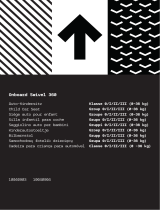
‑ 18 ‑DE
•
Alle Gurte, mit denen die Rückhaltevorrichtung am Fahrzeug befesgt ist,
müssen stra sein. Die Gurte, mit denen das Kind gesichert ist, müssen an
den Körper des Kindes angepasst und dürfen nicht verdreht sein.
•
Stellen Sie sicher, dass die Beckengurte niedrig sind, damit das Becken
festgehalten wird.
•
Wenn das Gerät während eines Unfalls plötzlichen Belastungen ausgesetzt
war, muss es ausgetauscht werden.
• Nehmen Sie ohne Zusmmung der zuständigen Behörden keine Änderungen
am Sitz vor und bauen Sie keine zusätzlichen Komponenten ein. Um maximale
Sicherheit für Ihr Kind zu gewährleisten, muss das Gerät gemäß den
Anweisungen des Herstellers gesichert und verwendet werden.
•
Die Kunststoeile dieses Autositzes können sich in der Sonne erwärmen und
Verbrennungen auf der Haut des Babys verursachen.
• Schützen Sie den Sitz vor der Sonne. Andernfalls ist der Sitz möglicherweise
zu heiß für die Haut Ihres Kindes.
• Lassen Sie Ihr Kind niemals unbeaufsichgt in der Zurückhaltung.
•
Gepäck und andere Gegenstände, die bei einem Zusammenstoß Verletzungen
verursachen können, müssen ordnungsgemäß gesichert werden.
•
Ein Kinderrückhaltesystem ohne Polster sollte nicht verwendet werden. Es
ist nicht gestaet, die Sitzpolster zu ersetzen, wenn dies nicht vom Hersteller
empfohlen wird, da dies ein wesentlicher Bestandteil des Geräts ist, der dessen
Funkon beeinträchgt.
• Bewahren Sie die Bedienungsanleitung für den Sitz auf, wenn Sie das Gerät
verwenden. Bewahren Sie es im Auto auf, in dem der Autositz installiert ist.
•
Verwenden Sie keine anderen tragenden Berührungspunkte als die in der
Anleitung beschriebenen und auf der Kindersicherung angegebenen.
•
Wenn Sie Zweifel an der Posion des Sicherheitsgurtschlosses für Erwachsene
in Bezug auf die Hauptlastpunkte haben, wenden Sie sich an den Hersteller
des Kinderrückhaltesystems.
4. Set (Abb. 2)
A. Gri
B. Rückenlehne
C. Gurte
D. Schnalle
E. Sitzpolste
F. Gurteinstellband
G. Gurtschlitz
H. Gurtschiene
I. Beckengurt






















